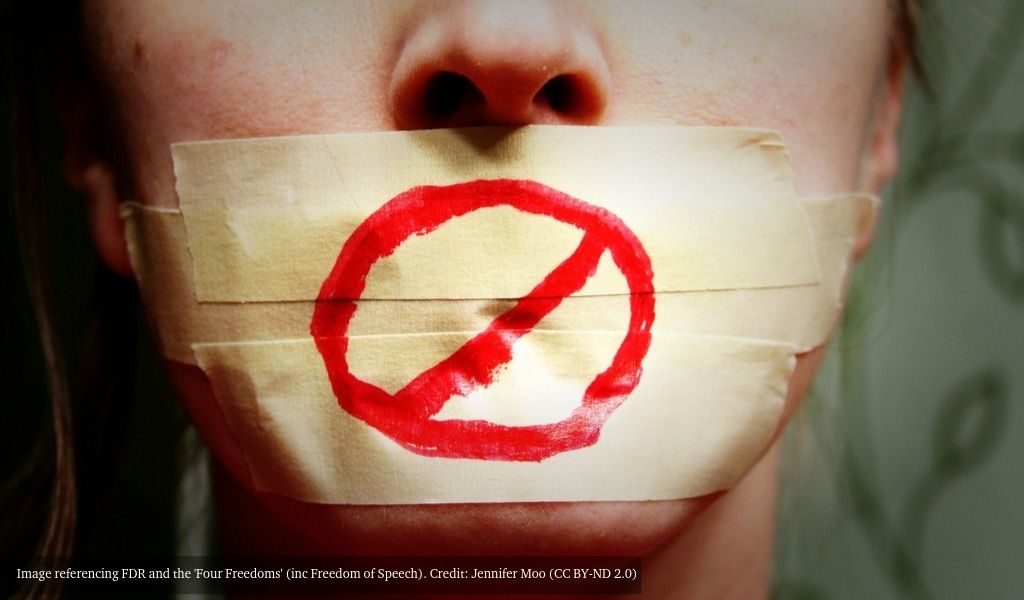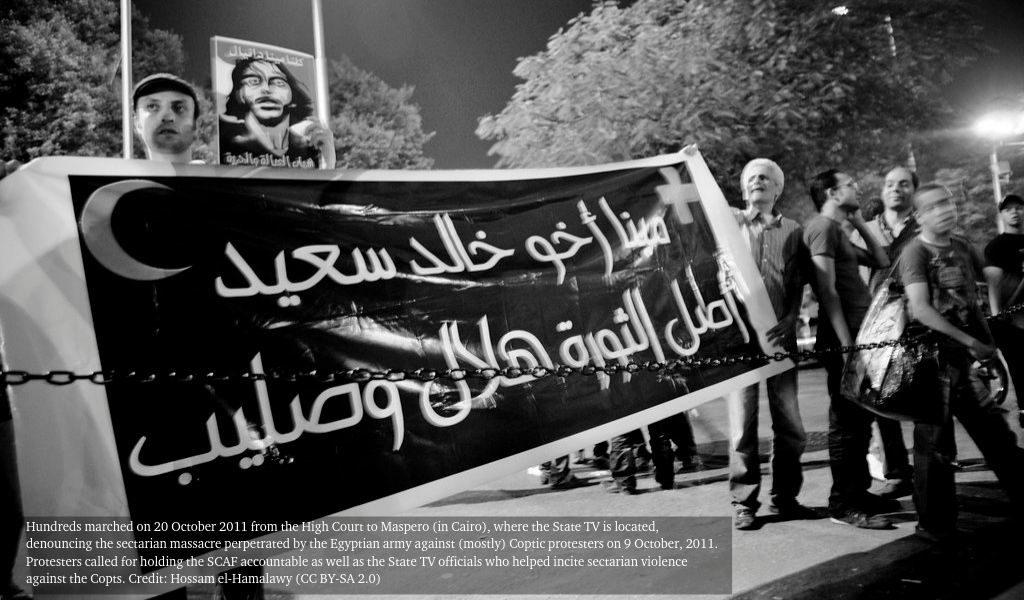Ahead of tomorrow’s Global Conference for Media Freedom hosted by the UK and Canadian governments in London, Professor Mariz Tadros, Director of the Coalition for Religious Equality and Inclusive Development (CREID) reflects on the tensions between protecting Freedom of Religion or Belief and media freedom.

Tribute to FDR and the Four Freedoms which includes Freedom of Speech. Credit: Jennifer Moo (CC BY-ND 2.0)
To pit freedom of expression against freedom from hateful speech is superficial, but to suggest that they are in perfect synergy as all rights are indivisible may also be a way of glossing over the dilemmas, conundrums and moral and political quandaries on the ground.
We can do a great deal of wordsmithing, develop sophisticated legal and philosophical cases to distinguish between what needs to be protected in the name of media freedom and what needs to be protected in the name of countering hate speech.
However, on the ground, the line is very, very thin to draw. At a time when so many rights are under fire globally, there is a sense of urgency to protect both.
In principle, media freedom and freedom of religion or belief are mutually re-enforcing. For example, without freedom of the media, local, national and international publics will be denied the right to know the nature, scale and intensity of violations on the basis of religion or belief.
State and non-state actors are using increasingly sophisticated methods for intimidating, censoring and punishing reporters and whistle-blowers, as well as obstructing people’s access to information.
Just recently, alarm bells were raised when the Myanmar government brought down cellular and internet connections under the guise of protecting people. Speaking to The New York Times, U Aung Thaung Shwe, a member of Parliament from Buthidaung Township in northern Rakhine State expressed concern that there will be more human rights violations in relation to the ethnic groups there during the internet shutdown.
Freedom of the media is also important for freedom of religion or belief in creating alternative spaces and platforms through which religious minorities and atheists (in contexts where neither are tolerated) are able to express their voices, to present counter-narratives to the mainstream one that either ignores, reifies or demonises them.
It is not that these platforms are just for venting out (although sometimes that is important) it is that they also create space for a plurality of voices who would not necessarily have the physical space to engage or for others to hear them. However, again, because of the clampdown on online media and the power of cyber armies, religious minorities who are vulnerable find themselves now having to retreat engaging in these spaces out of fear of reprisals (a theme that was raised in our recent CREID conference).
At the launch of this year’s FCO’s report on human rights (PDF) last month, the theme of the event was media freedom, whilst tomorrow, the UK and Canadian governments are hosting a Global Conference for Media Freedom to promote media freedom.,
While engagement between religious actors and the media is indeed welcome, protection of freedom of religion or belief in relation to media freedom throws a whole set of other issues.
When media freedom becomes media impunity…
The first issue is impunity for the role of the media in inciting violence against religious minorities.
Perhaps one clear example of the relationship between media incitation of violence and assault on religious minorities can be drawn from the events of 8th of October 2011 dubbed Egypt’s bloody Sunday.

Hundreds marched on 20 October 2011 from the High Court through downtown Cairo streets, to Maspero, where the State TV is located. Marchers were denouncing the sectarian massacre perpetrated by the Egyptian army against (mostly) Coptic protesters on 9 October. Protesters called for holding the SCAF accountable as well as the State TV officials who helped incite sectarian violence against the Copts. Credit: Hossam el-Hamalway (CC BY-SA 2.0)
In this particular incident, the state-run television claimed that the country’s Copts had put the Egyptian army in peril. Subtitles at the bottom of the screen read: “Urgent: The Army Is Under Attack by Copts.” The presenter called upon all “honorable citizens” to go down to the city centre (Maspero) to help defend Egyptian soldiers against the attacks. Christian and Muslim citizens had peacefully gathered to protest at Maspero the state’s failure to protect places of worship. Around this time, (fake) news was also circulated that that two officers had been martyred at Coptic hands.
That evening, many residents of Bulaq and other nearby working-class districts armed themselves with clubs and other weapons, before heading off to Maspero to assist the army in beating up and even killing protesters. One corpse had its head split in two, clearly by a sword or another sharp instrument, not an army-issue weapon. To this day the presenter and more importantly the actors who had asked her to relay this message on prime time national television have enjoyed impunity.
Clearly with media freedom comes the need for accountability for incitement of violence.
Understanding and addressing the links between the mobilisation of hate online and offline violence is not straightforward
There is a growing body of evidence emerging on the mobilisation of hate via the online media and offline violence however, there are a number of challenges in redressing this which are not so straightforward.
First is the regulation of multinational corporations which are responsible for mediating the online spaces through which hate content is uploaded. This is by no means an easy task given the scale of information put up everyday and the speed needed to respond. A Reuters report published last year highlighted just how fraught an issue this was for social media giant Facebook, whose role as a platform for mediating hate speech in Myanmar was highlighted and condemned by the UN earlier in the year.
What is most contentious – and where the tensions between media freedom and protection of religious minorities and those of no belief is most acute – is where the content cannot be easily classified as inciting violence or propagating hate.
Many proponents of media freedom would argue that this is where the line is to be drawn.
Yet what about the circulation of a rumour about a romantic relationship between a man or woman of different religious/ethnic affiliations? In itself this may not count as violence or hate. But in the contexts in which this rumour is being circulated, its effect can be on par to a direct call to violence.
In many cases, the spread of such rumours are enough to mobilise in the space of a few hours mobs to attack not just the individuals in question, but the entire community which could be in a weak or vulnerable position, for example due to being a numerical minority (although this is not always necessarily the case).
The impact of the publishing or reporting of such rumours is far-reaching.
It is not enough to raise awareness among the population not to trust all media matter, it is not enough present counter-information announcing that it is fake news.
Often by then the harm has already been done. By then, the damage has been done: people have lost their lives, houses have been burnt, a minority has been evicted from their homes and in some cases worse.
Proponents of media freedom would argue that it is the responsibility of state actors to protect citizens from physical violence, and the onus is not on the media. But in contexts of fragility, volatility and the speed with which a rumour tips over into action against a vulnerable religious group on the ground, we need to ensure a good balance between an accountable and free media.
